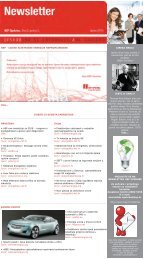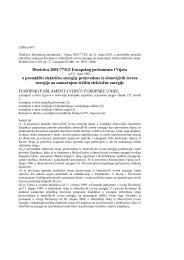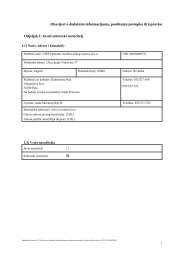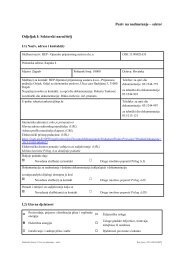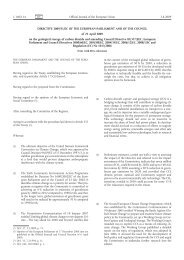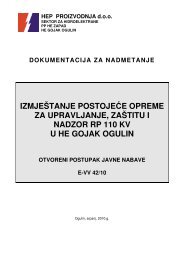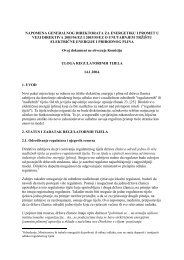DRAVA, KUPA, RJE»INA, LOKVARKA, LI»ANKA LIKA, DOBRA ...
DRAVA, KUPA, RJE»INA, LOKVARKA, LI»ANKA LIKA, DOBRA ...
DRAVA, KUPA, RJE»INA, LOKVARKA, LI»ANKA LIKA, DOBRA ...
Create successful ePaper yourself
Turn your PDF publications into a flip-book with our unique Google optimized e-Paper software.
HEP ANNUAL REPORT 2010<br />
80<br />
CHAPTER 6 - FINANCIAL STATEMENTS<br />
NOTES TO THE CONSOLIDATED FINANCIAL<br />
STATEMENTS OF THE HEP GROUP (CONTINUED)<br />
FOR THE YEAR ENDED 31 DECEMBER 2010<br />
2. SUMMARY OF SIGNIFICANT ACCOUNTING POLICIES (continued)<br />
FOREIGN CURRENCIES (continued)<br />
For the purpose of presenting consolidated financial statements, the assets and liabilities of the Group’s foreign<br />
operations are expressed in Croatian kuna using exchange rates prevailing at the date of the statement of financial<br />
position. Income and expense items are translated at the average exchange rates for the period, unless exchange<br />
rates fluctuated significantly during that period, in which case the exchange rates at the dates of the transactions<br />
are used. Exchange differences arising on the year-end translation, if any, are classified as equity and recognised in<br />
the Group’s foreign currency translation reserve. Such exchange differences are recognised in profit or loss in the<br />
period in which the foreign operation is disposed of.<br />
TAXATION<br />
The tax expense represents the sum of the tax currently payable and deferred tax.<br />
Current tax<br />
The tax currently payable is based on taxable profit for the year. Taxable profit differs from profit as reported in the<br />
income statement because it excludes items of income or expense that are taxable or deductible in other years and<br />
it further excludes items that are never taxable or deductible. The Group’s liability for current tax is calculated using<br />
tax rates that have been enacted or substantively enacted by the end of reporting period.<br />
Deferred tax<br />
Deferred tax is recognised on differences between the carrying amounts of assets and liabilities in the financial<br />
statements and the corresponding tax bases used in the computation of taxable profit, and are accounted for using<br />
the balance sheet liability method. Deferred tax liabilities are generally recognised for all taxable temporary differences,<br />
and deferred tax assets are generally recognised for all deductible temporary differences to the extent that<br />
it is probable that taxable profits will be available against which those deductible temporary differences can be<br />
utilised. Such assets and liabilities are not recognised if the temporary difference arises from goodwill or from the<br />
initial recognition (other than in a business combination) of other assets and liabilities in a transaction that affects<br />
neither the taxable profit nor the accounting profit.<br />
Deferred tax liabilities are recognised on the basis of taxable temporary differences on investments in subsidiaries<br />
and associates and joint ventures, unless the Group is able to control the reversal of the temporary difference<br />
and it is probable that the temporary difference will not reverse in foreseeable future.<br />
The carrying amount of deferred tax assets is reviewed at the end of each reporting period and reduced to<br />
the extent that it is no longer probable that sufficient taxable profits will be available to allow all or part of the<br />
asset to be recovered.<br />
Deferred tax assets and liabilities are measured at the tax rates that are expected to apply in the period in<br />
which the liability is settled or the asset realised, based on tax rates (and tax laws) that have been enacted or<br />
substantively enacted by the end of the reporting period. The measurement of deferred tax liabilities and assets<br />
reflects the amount in which the Group expects, at the reporting date, to recover or settle the carrying amount of<br />
its assets and liabilities.<br />
Current and deferred tax for the period<br />
Current and deferred tax are recognised as an expense or income in profit or loss, except when they relate to items<br />
credited or debited directly to equity, in which case the tax is also recognised directly in equity, or where they arise<br />
from the initial accounting for a business combination.<br />
In the case of a business combination, the tax effect is taken into account in calculating goodwill or in determining<br />
the excess of the acquirer’s interest in the net fair value of the acquiree’s identifiable assets, liabilities and<br />
contingent liabilities over cost.




